Shin-Kobe Ropeway
Kitano-Cho
Kobe Harborland
Kobe City Musuem
Meriken Park
Nankinmachi (Kobe Chinatown)
Arima Onsen
Kobe Earthquake Memorial Museum
Mount Rokko
Sake Breweries
Akashi Kaikyo Bridge
Hyogo Prefectural Museum of Art
Sorakuen Garden
Sorakuen is a traditional Japanese landscape garden in the center of Kobe. The garden used to be part of the residence of Kodera Kenkichi, a former mayor of Kobe, but was opened to the public in 1941.
All the buildings which had originally stood in the garden, were destroyed in the war, except for a stable. The former home of a foreign trader, the Hassam House, was moved into the Sorakuen Garden from the Kitano district in 1961.
How to get there
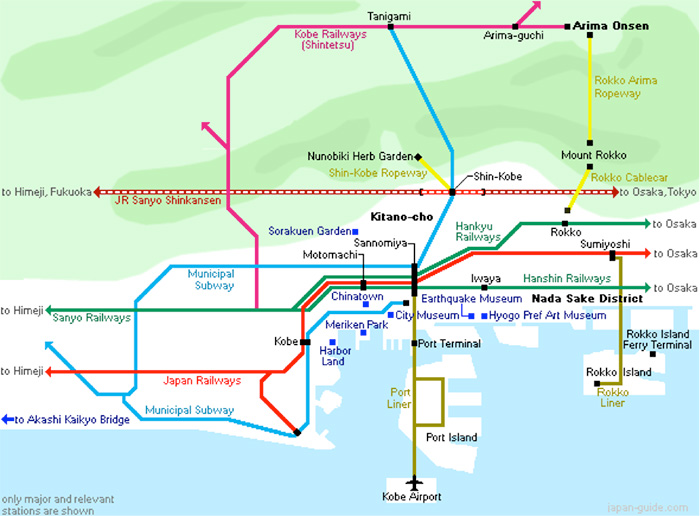
Sorakuen is a ten minute walk north of Motomachi Station (JR and Hanshin Railways) and a five minute walk north of Kencho-mae Station (Kobe Subway).
Hours and Fees
| Hours: | 9:00 to 17:00 (entry until 16:30) |
| Closed: | Thursdays (or following day if Thursday is a national holiday), December 29 to January 3 |
| Admission: | 300 yen |
Shin-Kobe Ropeway
Shin-Kobe Ropeway (新神戸ロープウェー) is one of the three services that lifts tourists up the southern slopes of the Rokko mountain chain. The ropeway departs from next to Shin-Kobe station, Kobe’s shinkansen station. As it ascends, it passes by the Nunobiki Waterfall and the Nunobiki Herb Garden, giving a nice aerial view of both. The highlight of the ride lies in the observation deck located just beside the top station, which offers spectacular views of Kobe and is a popular night view spot.
An alternative way to get to the top station is via a hiking trail from Shin-Kobe station. It is somewhat surprising that only a few steps north of the station are forests shielded from the rumbles of the city. A 15 – 20 minute climb through the woods takes you to the 43 meter tall Nunobiki Waterfall, whose name comes from its draped cloth-like appearance. Five minutes east from here is the Miharashi Observatory, which offers decent vies of the city.
A further 20 minute scale up the mountain takes you to the middle station of Shin-Kobe Ropeway and the lower entrance of Nunobiki Herb Garden, one of Japan’s largest herb gardens with hundreds of herb species and seasonal flowers. A glasshouse in the garden makes growing flowers and fruits such as guavas and papayas possible throughout the year.
At the upper entrance of the garden is the top station of Shin-Kobe Ropeway. Here, in addition to the observation deck, is a rest house with a café, restaurant and souvenir shop which sells many herbal and aromatic products. There is also a “Rose Symphony Garden”, where visitors can enjoy viewing different varieties of roses during their blooming seasons while listening to music.
For hikers who would rather skip the garden, the top station and observation deck can be hiked to following a 30 minute trail that bypasses the garden on its east. After reaching the ropeway’s top station, the same trail continues on to Mount Maya, one of the peaks of the Rokko mountain chain.
How to get there

It takes five minutes to walk from Shin-Kobe Station to the lower station of Shin-Kobe Ropeway.
To access the hiking trail to the waterfall, leave Shin-Kobe Station through the exit on the first floor to the south (the ticket gates are located on the second floor), where you will find a tunnel that leads below the station building northwards to the forested mountain.
Hours and Fees
Shin-Kobe Ropeway
| Hours: | 10:00 to 17:00 (until 20:30 on weekends, national holidays and July 20 to August 31) Admission ends 15 minutes before closing time |
| Closed: | No closing days |
| Admission: | 1400 yen (round trip and admission to herb garden) 900 yen (one way and admission to herb garden) 800 yen (round trip after 17:00) |
Nunobiki Herb Garden
| Hours: | 10:00 to 17:00 |
| Closed: | No closing days |
| Admission: | 200 yen (herb garden only) |
Kitano-Cho
Kitano-cho (北野町, Kitanochō) is a city of district at the foot of the Rokko mountain range where many foreign merchants and diplomats settled after the Port of Kobe was opened to foreign trade in the second half of the 19th century. More than a dozen of the former mansions, known as Ijinkan, remain in the area and are open to the public as museums.
Most of the houses charge an admission fee between 550 to 750 yen, which combination tickets are available to see multiple houses. The entire district is pleasant to walkm through and offers a variety of cafes, restaurant and boutiques, making it a favorite among young Japanese couples. Below is a list of some of the more interesting houses:
England House
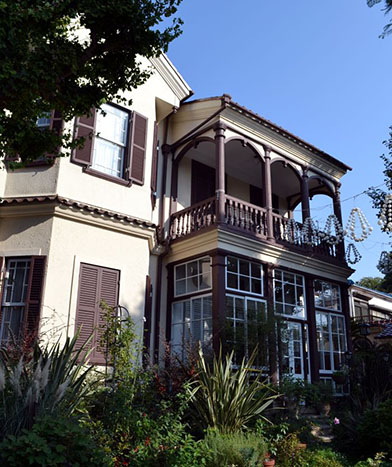
The England house was built in 1907 and displays antique furniture and household items of the time period. The house has two ornately carved bars (which are open for business on Sundays and holidays from 17:00 to 25:00). The second floor houses a collection of Sherlock Holmes memorabilia including a replica of Sherlock Holmes' room.
Hours and Fees
| Hours: | 09:00 to 18:00 (until 17:00, October to March) |
| Closed: | No closing days |
| Admission: | 750 yen (Also available as part of a combination ticket) |
Yokan Nagaya (France House)
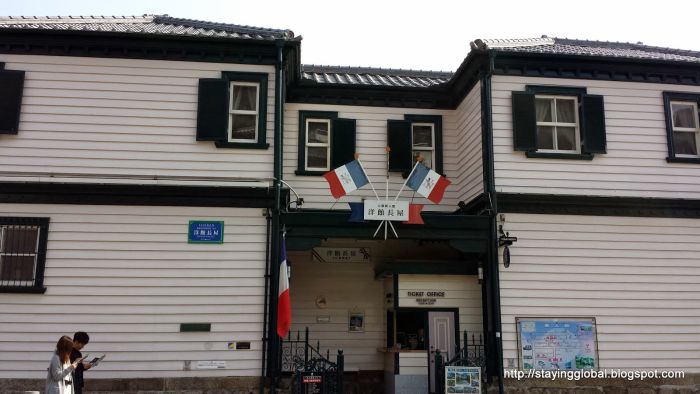
The Yokan Nagaya was originally built in 1904 as an apartment catering to foreigners. It is furnished in ornate French furniture and artwork and includes a few examples of antique brand goods such as a stained glass Tiffanty lamp and a set of Louis Vuitton trunks.
Hours and Fees
| Hours: | 09:00 to 18:00 (until 17:00, October to March) |
| Closed: | No closing days |
| Admission: | 550 yen (Also available as part of a combination ticket) |
Ben’s House
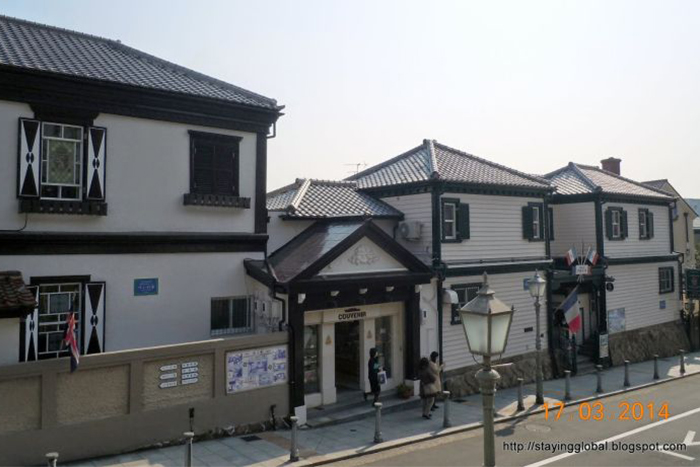
Ben’s House was built in 1902 and is one of the district’s oldest Western Style buildings. It is the former home of Englishman Ben Allison, an avid hunter and world traveler, and the house is filled with stuffed animals, including tigers, a moose, a polar bear and other trophies collected from around the world.
Hours and Fees
| Hours: | 09:00 to 18:00 (until 17:00, October to March) |
| Closed: | No closing days |
| Admission: | 550 yen (Also available as part of a combination ticket) |
Platon Decorative Arts Museum (Italian House)
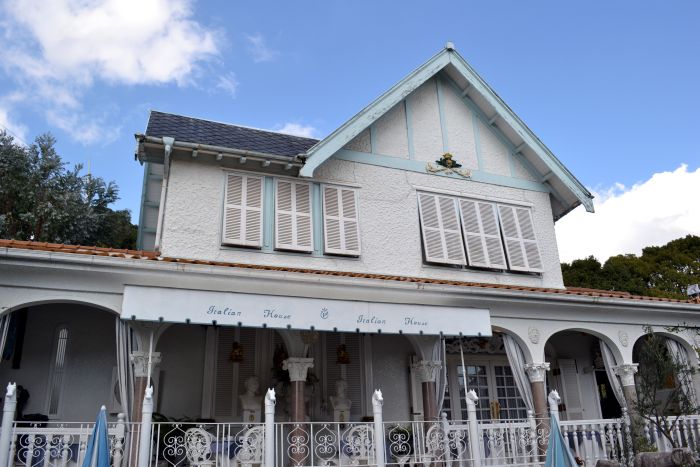
The Platon Decorative Arts Museum, otherwise known as the Italian House, is a foreigner’s former residence built in the 1910s whose living and bed rooms, kitchens and servant quarters are filled with an overwhelming amount of household goods, artwork and ornaments. The house also features a small outdoor café serving Italian cuisine.
Hours and Fees
| Hours: | 09:30 to 17:00 |
| Closed: | No closing days |
| Admission: | 700 yen |
Former Chinese Consulate
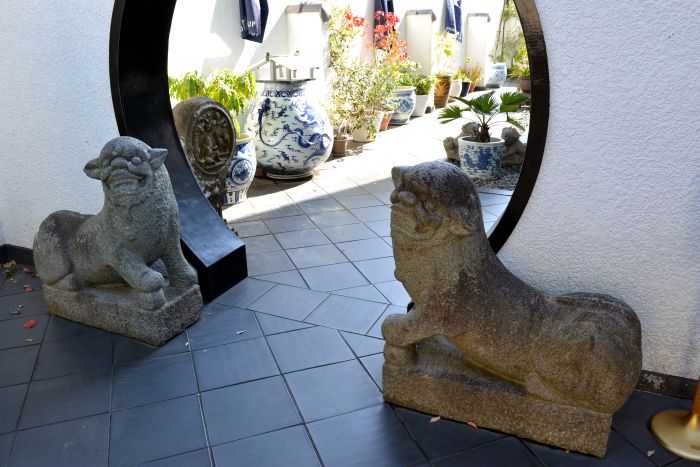
The Former Chinese Consulate was built in the late Meiji Period. Although generally Western, the architecture of the building has some distinctly Chinese elements, and the inside is furnished with Chinese-style furniture and household items. On display are various art pieces, some of which date back several centuries.
Hours and Fees
| Hours: | 09:00 to 18:00 (until 17:00, October to March) |
| Closed: | No closing days |
| Admission: | 550 yen (Also available as part of a combination ticket) |
Kitano Foreigners Association
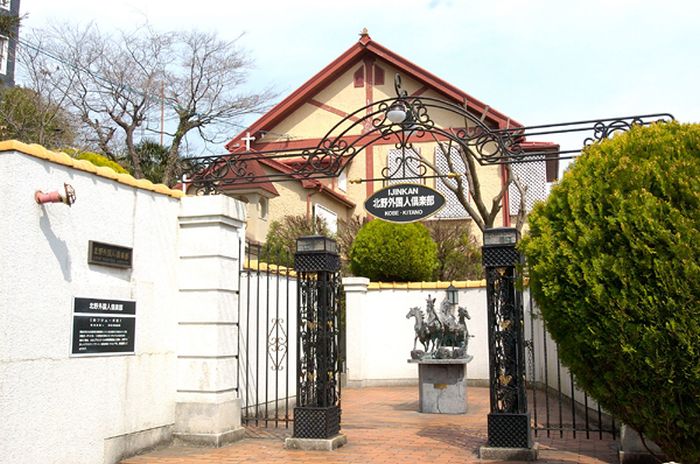
The Kitano Foreigners Association was a members-only social club frequented by the foreign residents who moved to Kobe after the port was opened up to international trade in 1868. This former residence, built in the late Meiji period, reproduces the salon, featuring a bar, lounge and old-style kitchen complete with a wood burning hearth.
Hours and Fees
| Hours: | 09:00 to 18:00 (until 17:00, October to March) |
| Closed: | No closing days |
| Admission: | 550 yen (Also available as part of a combination ticket) |
Yamate Hachibankan
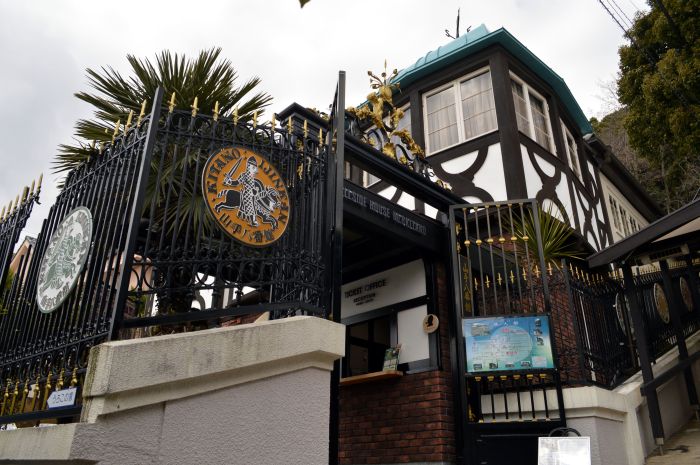
Yamate Hachibankan is a Tudor-style mansion built in the late Meiji Period. It exhibits various sculptures and other artwork by Rodin, Bourdelle and Renoir, as well as collections of Buddhist relics and African tribal figures.
Hours and Fees
| Hours: | 09:00 to 18:00 (until 17:00, October to March) |
| Closed: | No closing days |
| Admission: | 550 yen (Also available as part of a combination ticket) |
Uroko House and Uroko Museum
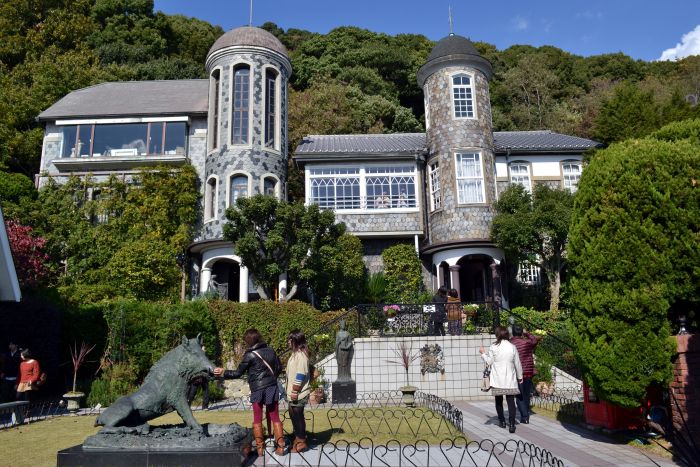
The Uroko House is named after fish scales because of its overlapping shingled siding. Inside you will find a collection of antique furniture and household items in one part of the house and a small museum with paintings by Russian modern artists in the other. There are also nice views over Kobe from the museum’s top floor.
Hours and Fees
| Hours: | 09:00 to 18:00 (until 17:00, October to March) |
| Closed: | No closing days |
| Admission: | 1050 yen (Also available as part of a combination ticket) |
Dutch Museum and Fragrance House
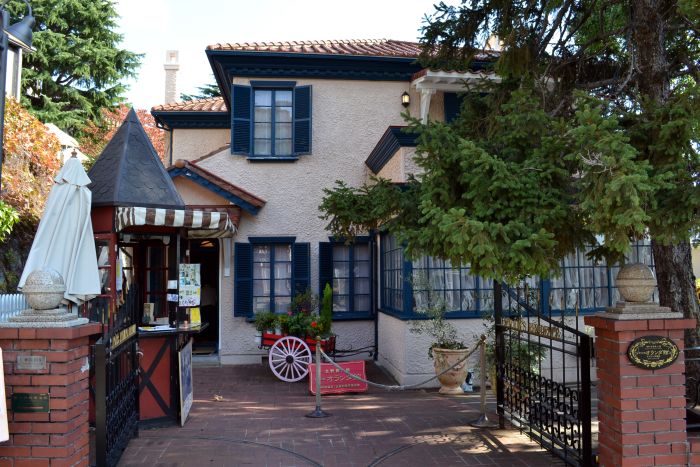
The Dutch Museum once served as the residence of the Dutch Consul General, and now displays Dutch furniture and household items from past decades. Part of the house is devoted to fragrances, including a gift shop selling scented soaps and perfumes and a workshop where visitors can make their own original perfumes.
Hours and Fees
| Hours: | 09:00 to 18:00 (until 17:00, January and February) |
| Closed: | No closing days |
| Admission: | 700 yen |
How to get there

Kitano-cho is about a 10 to 15 minute walk from either Sannomiya or Shin-Kobe stations.
Kobe Harborland
Kobe Harborland is a shopping and entertainment district along the waterfront of Kobe’s port area, offering many cafes, restaurants, shops and other amusements. It is also a popular dating spot.
The two largest shopping complexes in the area are Mosaic and Canal Garden. Mosaic is a pleasant shopping complex along the waterfront with a variety of small fashion boutiques and a wide selection of restaurants, many of which overlook the harbor. A small amusement park with ferris wheel is found at one end of Mosaic. Canal Garden, on the other hand, is a shopping mall with a Hankyu department store, Sofmap electronics store, a sports store and various family fashion outlets.
The shopping area is surrounded by walking paths and promenades including a waterfront boardwalk and the Gaslight Street, a street that is lit in the evenings by old-fashioned gas street lights. Other attractions in the area include a cinema and a few restaurants housed in renovated 19th-century brick warehouses which remain from a former dockyard.
How to get there

Kobe Harborland starts just outside of JR Kobe Station and the Harborland Subway Station. Alternatively, it can be reached in a five minute walk from Meriken Park.
Hours and Fees
| Hours: | Varies, most shops open from 10:00 to 20:00 Restaurants typically open from 11:00 to 22:00 with a break between lunch and dinner Amusement park open from 10:00 to 23:00 |
| Closed: | No closing days |
| Admission: | Free (Except amusement park rides) |
Kobe City Museum
The Kobe City Museum was opened in 1982, merging the collections of the Kobe Archaeological Museum and Namban Art Museum under the same roof. The museum’s permanent exhibition features an interesting collection of maps from different regions and eras of Japan, as well as artifacts representing Japan’s exchange with foreign countries, from its earliest cultural imports from China and Korea to traded goods that entered Kobe after its port was opened to international trade in the 19th century.
The museum also has one of the world’s largest collections of Namban Art (“Southern Barbarian Art”), a Japanese art style that developed out of the first contacts with Western trade ships (which approached Japan from the South) in the 1500s. The rotating exhibits include colorful paintings and folding screens which depict scenes of early Japanese contacts with foreign traders and missionaries.
The museum also periodically hosts temporary special exhibitions.
How to get there

The Kobe City Museum is about a ten minute walk from either Motomachi or Sannomiya Stations, or a five minute walk from Meriken Park.
Hours and Fees
| Hours: | 10:00 to 17:00 (09:30 to 17:30 during special exhibitions) |
| Closed: | 10:00 to 17:00 (09:30 to 17:30 during special exhibitions) |
| Admission: | 200 yen (When there is no special exhibitions), more expensive during special exhibitions |
| English | Minimal |
Meriken Park
Meriken Park is a nice waterfront park in Kobe’s port area. Built on an outcropping of reclaimed land, the park is covered in grassy lawn and open courtyards dotted with a collection of modern art installations and fountains. It is home to some of the city’s more iconic contemporary architecture such as the red Kobe Port Tower and the Kobe Maritime Museum.
The park was devastated by the 1995 Great Hanshin Earthquake, but has now become a popular spot for locals and tourists again. A small memorial in the park commemorates the many victims who were killed in the port during the earthquake. A short section of damaged waterfront has been left unrepaired as a reminder of the earthquake’s tremendous destructive power.
The Kobe Maritime Museum stands at the center of the park in a building topped by a dramatic white steel framework meant to evoke the image of sails. Half of the building is devoted to shipping. The first floor explains how Kobe Port functions and exhibits models of modern ships. The second floor introduces the history of the port and how it has been an important connection between Japan and the outside world. Actual historic boats are on display outdoors around the museum.
The other half of the Maritime Museum building is occupied by the Kawasaki Good Times World, the corporate museum of Kawasaki Heavy Industries, manufacturer of various mechanical components and vehicles including shinkansen trains, jet planes, helicopters and motorcycles. The museum exhibits the history of the company and its many successful products, and visitors are encouraged to have hands-on experiences with some of the vehicles.
To the west of the Maritime Museum stands the Kobe Port Tower, a unique, red-painted steel structure that has become a symbol of the port and the city. Built in 1963, the tower stands 108 meters tall and visitors may take an elevator up to its five top floors. Two of the floors house a restaurant and a rotating café, while the other three house observation decks that provide 360-degree views of the city from approximately 100 meters above ground.
Next to the tower, between Meriken Park and Kobe Harborland, sits the Nakatottei Chuo Terminal where sightseeing boats depart on lunch and dinner cruises around Kobe Bay and to the Akashi Kaikyo Bridge. Cruises take around one to two hours and cost from 1100 to 3300 yen.
How to get there

Meriken Park is about a ten minute walk south of Motomachi Station or just across the sightseeing cruise terminal from Kobe Harborland.
Hours and Fees
Kobe Port Tower
| Hours: | 09:00 to 21:00 (until 19:00, December to February) Admission ends 30 minutes before closing |
| Closed: | No closing days |
| Admission: | 700 yen (Tower only) 1000 yen (Tower, Maritime Museum and Kawasaki Museum) |
Kobe Maritime Museum and Kawasaki Good Times World
| Hours: | 10:00 to 17:00 (Entry until 16:30) |
| Closed: | Monday (or following dat if Monday is a national holiday), December 29 to January 3 |
| Admission: | 600 yen (Both museums) 1000 yen (Both museums and Port Tower) |
| English | Moderate |
Nankinmachi (Kobe Chinatown)
Nankinmachi is a compact Chinatown in central Kobe and a center of the Chinese community in the Kansai Region. The area was developed by Chinese merchants who settled near Kobe Port after the port was opened to foreign trade in 1868. As the Chinatown developed, it became known as Nankinmachi after Nanjin, the former Chinese capital.
Nankinmachi is a popular tourist attraction and shopping and dining district. Two main streets run through the district, meeting each other at a small plaza in the center. They are packed with shops, restaurants and food stands that sell popular items such as steamed buns (manju), ramen, tapioca drinks and various other Chinese dishes, many of which have been Japanized to a certain degree.
How to get there

Nankinmachi is located a five minutes walk south of Motomachi Station, a ten minute walk southwest of Sannomiya Staion or a five minute walk north of Meriken Park.
Hours and Fees
Shops
| Hours: | Varies by shop. Typically 10:30 to 19:00. |
| Closed: | Varies by shop. Many shops have no closing days. |
| Admission: | 700 yen (Tower only) 1000 yen (Tower, Maritime Museum and Kawasaki Museum) |
Restaurants
| Hours: | Varies by restaurant. Typically 11:30 to 21:00. Some close between 15:00 to 17:00. |
| Closed: | Varies by restaurant. Many restaurants have no closing days. |
Arima Onsen
Arima Onsen (有馬温泉) is a famous hot spring town within the city limits of Kobe, but on the opposite side of Mount Rokko from the city center. The town lies in a natural mountain setting, yet is close enough for Kobe and Osaka residents as an easy and popular day trip or weekend getaway.
Although Arima Onsen has a modern look today and is pretty built up, one can still find several narrow lanes and wooden buildings when strolling around the center of town. Due to its compact size, the small town can be explored entirely on foot, and there are several hot spring sources, nice temples and shrines and a small hot spring museum (200 yen) to be discovered.
With a history of over one thousand years, Arima Onsen is considered one of Japan’s oldest hot spring resorts and has often stood at or near the top of onsen rankings for Western Japan. The town has two types of hot spring waters which spring up at various sources around town: the Kinsen (“gold water”) is colored brown with iron deposits and is said to be good for skin ailments and muscle pain, while the clear Ginsen (“silver water”) contains radium and carbonate and is said to cure various muscle and joint ailments.
Visitors to Arima Onsen can enjoy hot spring bathing at two public bath houses or at the town’s many ryokan. Several ryokan open their baths also to non-staying visitors during the day. The admission fee for a daytrip visit to a bath typically ranges between 500 and 2500 yen.
The following is a list of some hot spring baths around Arima Onsen hat are open to day trip visitors:
Kin no Yu
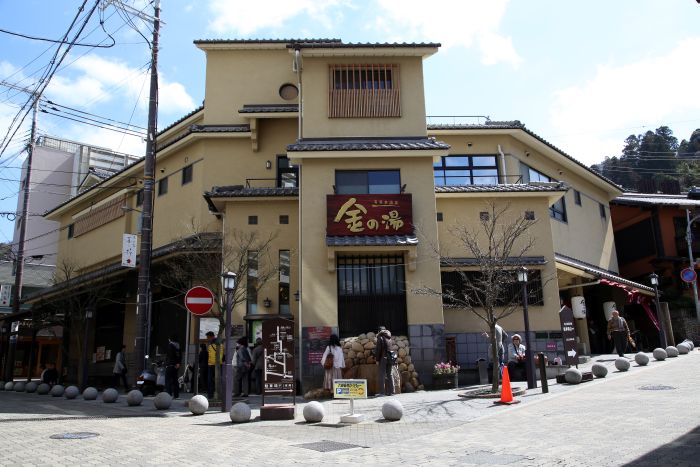
Located at the center of town, Kin no Yu is the larger of Arima Onsen's two public bath houses. It features two indoor 'gold" water baths of varying temperatures for each gender. Outside the bath house there are a free foot bath (ashiyu) and a drinking fountain fed by thermal waters).
Hours and Fees
| Hours: | 08:00 to 22:00 (Admission ends at 21:30) |
| Closed: | 2nd and 4th Tuesday each month (Wednesday if Tuesday is a holiday), January 1 |
| Admission: | 650 yen |
Gin no Yu
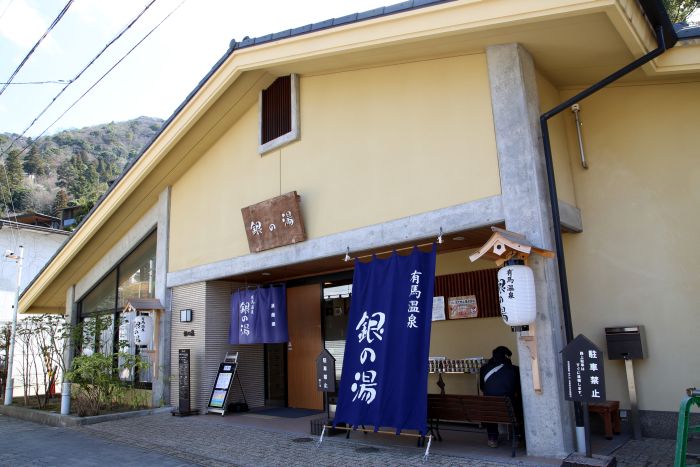
Gin no Yu stands for further back in the town, and is the smaller of Arima’s two public bath houses. It has one large indoor bath for each gender, featuring the clear, “silver” water.
Closed for renovation until summer 2015
Taiko no Yu
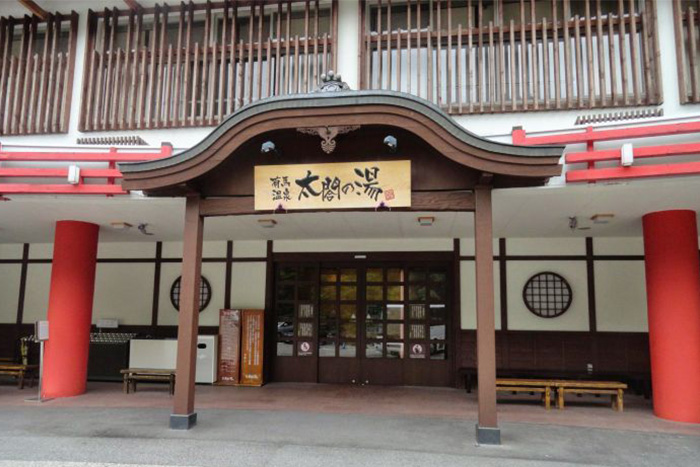
Part of the Arima View Hotel, the Taiko no Yu is a large modern hot spring facility, featuring a wide variety of indoor and outdoor baths filled with both of Arima’s waters. It includes a replica of a historic bath found at the onsen museum, large pots and fragrant saunas. In addition, there are massage services, restaurants, shops and rest areas.
Hours and Fees
| Hours: | 10:00 to 23:00 (Entry until 22:00) |
| Closed: | Small number or irregular closing days |
| Admission: | 2400 yen (Weekdays), 2600 yen (Weekends and during holidays) |
Goshobo
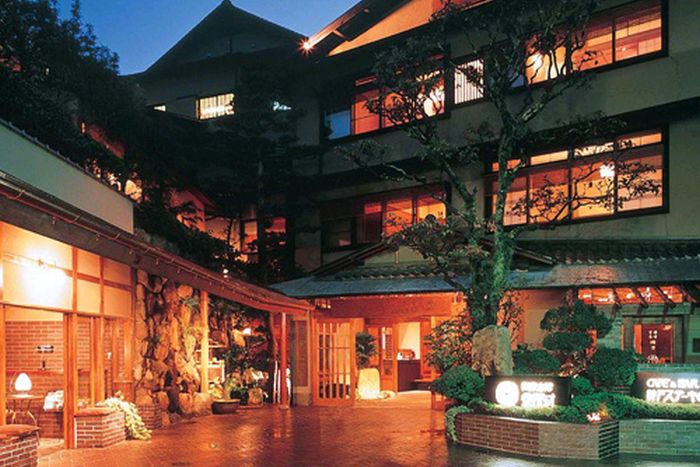
Goshobo, one of Arima’s oldest ryokan, opens its baths to non-staying guests during daytime. Its main baths are atmospheric indoor stone pools for each gender, filled with Arima Onsen’s famed “golden” hot spring water.
Hours and Fees
| Hours: | 11:00 to 14:00 |
| Closed: | Weekends and public holidays |
| Admission: | 1620 yen |
| Overnight Stay: | From 20,000 yen per person including 2 meals |
How to get there
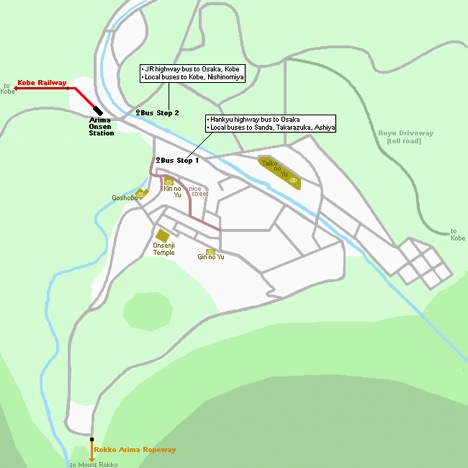
By train
From Sanomiya or Shin-Kobe station, take the subway to Tanigami Station (10-15 minutes, 4 -5 departures per hour). Then, take the Shintetsu Arima-Sanda Line to Arima-guchi and transfer to the Arima Line to Arima Onsen Station (20 minutes, 4 departures per hour). The entire journey takes 30-40 minutes and costs 740 yen from Shin-Kobe and 930 yen from Sannomiya Station.
By direct bus from Kobe
Hankyu and Shinki Bus operate local buses from Sannomiya Station (50 minutes) via Shin-Kobe Station (35 minutes) to Arima Onsen (using bus stop 1 on the map). The one way trip costs 700 yen and buses depart once or twice an hour. Alternatively, JR Bus operates about seven highway buses per day from Shin-Kobe Station (50 minutes) via Sannomiya Station (30 minutes) to Arima Onsen (using bus stop 2 on the map). The one way trip costs 770 yen, while a round trip ticket is available for 1440 yen. The Japan Rail Pass and other JR passes are not valid on any of these buses.
By direct bus from Osaka
Hankyu Bus and JR Bus operate one or two highway buses per hour from Hankyu Umeda Station or JR Osaka Station (60 minutes, 1370 yen) via Shin-Osaka Station (50 minutes, 1230 yen) to Arima Onsen. In Arima, Hankyu Bus uses bus stop 1 on the map, while JR Bus uses bus stop 2. The Japan Rail Pass and other JR passes are not valid on either bus.
By cablecar and ropeway via Mount Rokko
From Sannomiya Station, take the Hankyu Kobe Line to Rokko Station (7 minutes, 190 yen), from where it is a ten minute, 210 yen bus ride by Kobe City Bus number 16 to the base station of the Rokko Cablecar.
The cablecar ride up the mountain takes ten minutes and costs 590 yen one way or 1000 yen for a round trip ticket. From the top station, take the circular bus line to the top station of the Rokko Arima Ropeway (ten minutes, 260 yen), which brings you down to Arima Onsen (12 minutes, 1010 yen one way, 1820 yen round trip).
If you access Arima Onsen via Mount Rokko, you can save some money by using the "Rokko Arima Katamichi Joshaken" ticket, which includes a one way ride on the cablecar and ropeway plus unlimited use of the circular bus line on Mount Rokko for 1750 yen.

Kobe Earthquake Memorial Museum
On January 17, 1995 at 5:46am, the city of Kobe was hit by the Great Hanshin Awaji Earthquake, resulting in the death of more than 5000 people and the destruction of tens of thousands of homes.
The Earthquake Memorial museum, part of the Disaster reduction and Human Renovation Institution, was opened in 2002 to commemorate the tragic event and to educate visitors about earthquakes and disaster prevention. The museum includes a large screen theater with realistic images of the earthquake's destructiveness, a documentary film about the recovery process, lots of information about the earthquake and various interactive games about disaster prevention.
How to get there

The Earthquake Museum is located in HAT Kobe, a relatively new city district east of the city center. It can be reached in a ten minute walk from Iwaya Station on the Hanshin Main Line (4 minutes, 140 yen from Sannomiya Station) or in a 15 minute walk from Nada Station on the JR Kobe Line (3 minutes, 120 yen from Sannomiya Station).
Hours and Fees
| Hours: | 09:30 to 17:30 (until 18:00 July to September, until 19:00 Fridays and Saturdays). Admission ends one hour before closing. |
| Closed: | Mondays (or following Monday id Monday is a national holiday, December 31 and January 1 |
| Admission: | 600 yen |
Mount Rokko
Mount Rokko (931 meters) is the highest peak in the Rokko mountain range, which provides the pleasant green backdrop to the city of Kobe. Panoramic views of the heavily urbanized Hanshin region (Kobe and Osaka) can be enjoyed from the mountain and are particularly spectacular around sunset.
Various small tourist attractions can be found on Mount Rokko, including a botanical garden, a music box museum, a pasture with flowers and sheep, Japan’s first golf course and Rokko Garden Terrace, a tourist complex with a few restaurants, shops and an observation deck.
A circular bus line (running in clockwise direction only) connects the various attractions with the top stations of both the Rokko Cablecar (going to central Kobe_ and the Rokko Arima Ropeway (going to Arima Onsen).
How to get there
From Central Kobe
From Sannomiya Station, take the Hankyu Kobe Line to Rokko Station (7 minutes, 190 yen), from where it is a ten minute bus ride on bus number 16 to the base station of the Rokko Cablecar. Note that the same bus can also be boarded at JR Rokkomichi Station (15 minutes) or Hanshin Mikage Station (25 minutes) and costs 210 yen from any of the three stations. The cablecar ride up the mountain takes 10 minutes and costs 590 yen one way or 1000 yen for a round trip ticket.
From Arima Onsen
The Rokko Arima Ropeway connects Arima Onsen with the top of Mount Rokko. The one way trip takes 12 minutes and costs 1010 yen. A round trip ticket costs 1820 yen.

Sake Breweries
Kobe’s Nada district is Japan’s top sake (rice wine) producing region. It has long been famous for its sake due to the availability of high quality rice, suitable water and favorable weather conditions in the area. Its proximity to Kobe Port and Osaka has also facilitated physical distribution since olden times.
Many sake breweries operate in the Nada district, which stretches approximately three kilometers east to west. Some open stores and/ or exhibition rooms to the public and allow guests to taste their sake. A couple of then also maintain a museum introducing the process of sake brewing.
The district makes for a good half-day walk exploring its nice mix of older buildings and modern breweries. If time is limited, we recommend visiting the Hakutsuru Sake Brewery Museum: its well-presented exhibits have comprehensive English coverage and sake tasting is available too.
Sawanotsuru Sake Museum
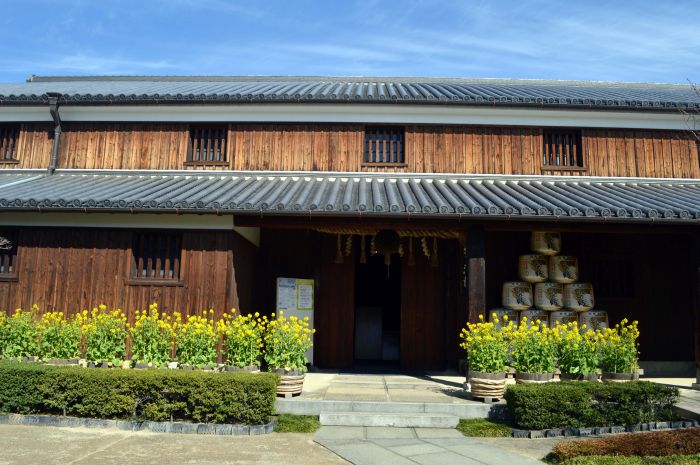
Sawanotsuru Sake Museum was opened in 1978 with the aim of commemorating the sake-brewing heritage of the Nada district. It was destroyed by the Great Hanshin Earthquake in 1995 and was subsequently rebuilt in 1999. Visitors can learn about traditional brewing methods and the ingredients involved. English pamphlets are available.
Hours and Fees
| Hours: | 10:00 to 16:00 |
| Closed: | Wednesdays, Obon and New Year holidays |
| Admission: | Free |
Kobe Konan Muko No Sato
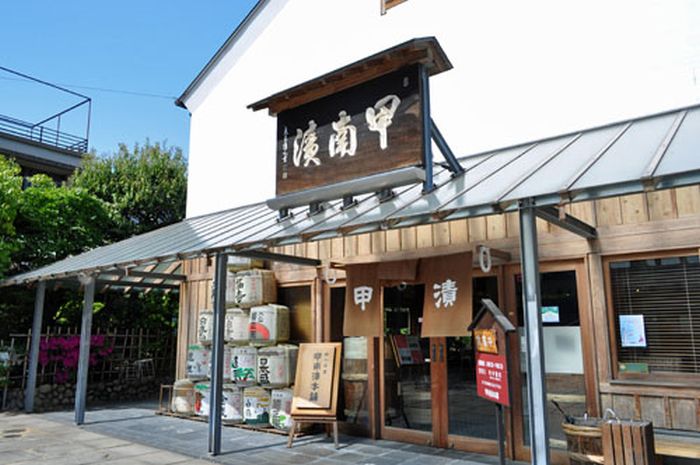
Rather than sake itself, foodstuff, condiments and pickles that are made with sake lees (sake leftovers after filtering) are the focus here. Kobe Konan Muko No Sato has a small museum which showcases different varieties of pickles and their making process. It also has a couple of restaurants and a big shop which sells a huge range of food which make good sake accompaniments.
Hours and Fees
| Hours: | 10:00 to 17:00 (Shop opens from 09:30 to 18:30) |
| Closed: | December 9 to January 5 |
| Admission: | Free |
Kobe Shushinkan Brewery
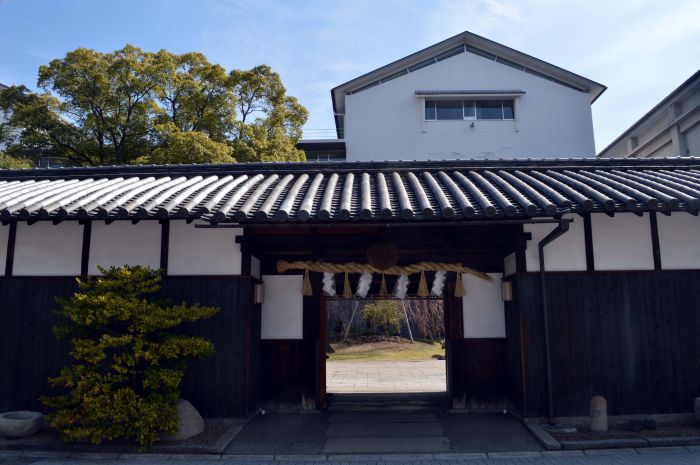
Shushinkan has a large shop selling sake and sake-related products. One free guided tour per day to visit its sake cellar is available upon reservation a day in advance. During winter only, brewery tours are conducted which actual brewing is carried out. Sake tasting is available as well.
Hours and Fees
| Hours: | 10:00 to 18:00 |
| Closed: | January 1 to 3 |
| Admission: | Free |
Hakutsuru Sake Brewery Museum
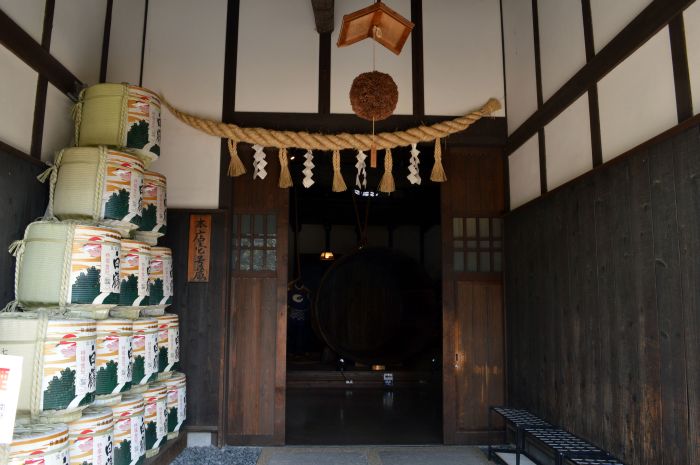
Good exhibits with life-sized replicas and models are presented at the Hakutsuru Sake Brewery Museum, a traditional building on the large grounds of a modern sake factory. The museum maintains a nice ambience and offers good English pamphlets and video clips explaining the sake brewing process. Sake tasting is available at its shop.
Hours and Fees
| Hours: | 09:30 to 16:30 (entry until 16:00) |
| Closed: | Monday (following day if Monday is a national holiday), Obon and New Year holidays |
| Admission: | Free |
Kikumasamune Sake Museum
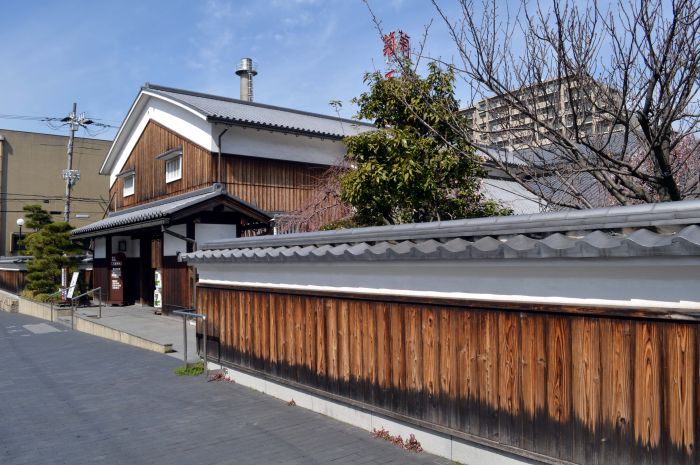
Kikumasamune Sake Museum is housed in a nice wooden-plaster building. Wooden tools, containers and machinery are exhibited in a room accompanied by atmospheric lighting and traditional music. Well-written pamphlets are available in nine languages.
Hours and Fees
| Hours: | 09:30 to 16:30 (Entry until 16:00) |
| Closed: | New Year holidays |
| Admission: | Free |
Sakuramasamune Sake
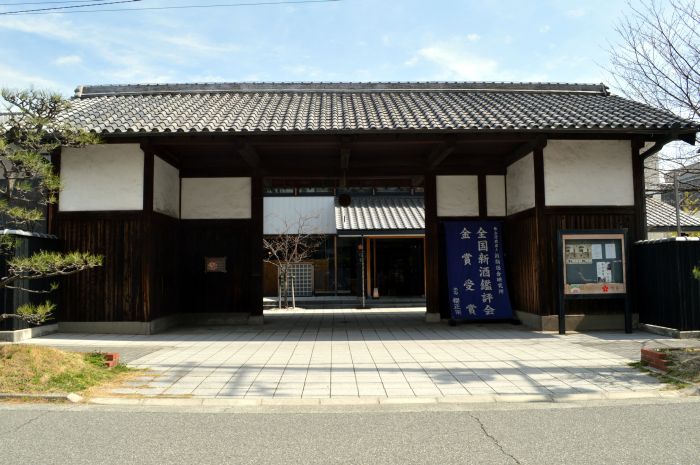
Sakuramasamune has a small exhibition space which showcases some tools and simple machines used in the past for sake production. there is also a video presentation showing clips of its traditional brewing process. Sake tasting is available at a shop selling its sake brews. There is limited English information at this location.
Hours and Fees
| Hours: | 10:00 to 19:00 |
| Closed: | Tuesdays |
| Admission: | Free |
Hamafukutsuru Ginjo Brewery
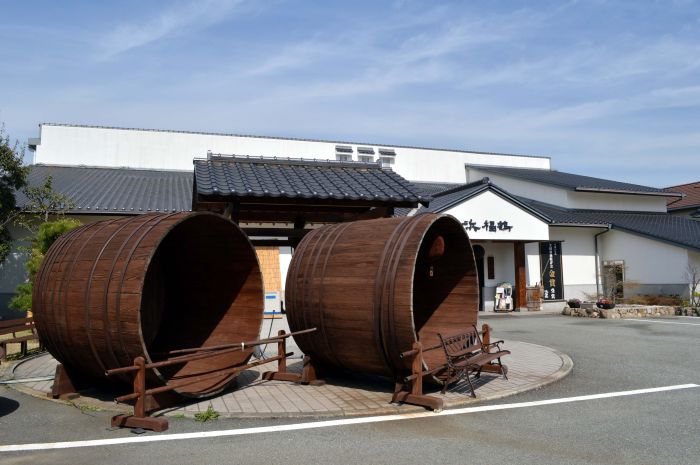
Hamafukutsuru has won several awards for its high-grade “ginjo” sake. The exhibition space on the second level of the building explains to guests their sake brewing process through diagrams and written information (English available). Visitors are also able to peer through the windows to look at brewing machines as they are being used.
Hours and Fees
| Hours: | 10:00 to 17:00 |
| Closed: | Mondays (Following day if Monday is a holiday), Obon and New Year holidays |
| Admission: | Free |
How to get there

Hanshin Railways, Hankyu Railways, and the JR Tokaido Line run parallel north of the Nada district, offering connections to both Kobe and Osaka. The stations on the Hanshin Line are the closes to the district and its attractions.
You may choose to start exploration of the district from any of the stations along it. The Hakutsuru Sake Brewery Museum can be reached in five minutes on foot from the Sumiyoshi Station on the Hanshin Railways Line (10 minutes, 190 yen from Sannomiya Station). Japan Rail Pass holders may want to alight at JR Sumiyoshi Station (8 minutes from JR Sannomiya Station), from where it is a 15-20 minute walk to Hakutsuru.
Akashi Kaikyo Bridge
The Akashi Kaikyo Bridge is, with a length of almost four kilometers, the world’s largest suspension bridge. Opened in 1998, it spans the Akashi Strait (Akashi Kaikyo) between Kobe and Awaji Island and is part of the Kobe-Awaji-Naruto Expressway, one of three expressways which connect Honshu with Shikoku.
The Bridge Exhibition Center at the foot of the Kobe side of the bridge provides well-presented information about the planning and construction of the bridge and about other suspension bridges around the world, although the detailed explanations are available in Japanese only.
The Maiko Marine Promenade consists of observatory hallways under the bridge’s platform, about 50 meters above the water. Accessed by elevator from the base of the bridge (Kobe side), the hallways offer interesting views of the bridge’s interior, the Akashi Strait and Osaka Bay.
Bridge enthusiasts should also consider participating in the “Bridge World” guided tour, which includes a visit to the very top of one of the bridge’s 300-meter-tall towers. The tour is in Japanese only, held twice a day on Thursdays, Fridays, Saturdays and Sundays, takes 2.5 hours, involves a lot of walking, costs 3000 yen per person and requires advance reservations.
How to get there

The Bridge Exhibition Center and the Maiko Marine Promenade are located a short walk from Maiko Station on the JR Sanyo Line (25 minutes, 300 yen from Sannomiya Station by local train) or Maiko-Koen Station on the Sanyo Railway Main Line.
Hours and Fees
Bridge Exhibition Center
| Hours: | 09:15 to 17:00 (Some seasonal variation) Admission ends 30 minutes before closing |
| Closed: | Mondays (or following day if Monday is a national holiday), December 29 to 31 |
| Admission: | 310 yen |
Maiko Marine Promenade
| Hours: | 09:30 to 18:00 (until 19:00 during summer holidays and golden week) |
| Closed: | Second Monday each month (or following day if Monday is a national holiday), December 29 – 31 |
| Admission: | 250 yen (310 yen on weekends and national holiday) |
Hyogo Prefectural Museum of Art
The Hyogo Prefectural Museum of Art is a modern and contemporary art museum found along the waterfront in the HAT Kobe district. It was built as part of the city’s recovery efforts after the 1995 Great Hanshin Earthquake, and was designed by Ando Tadao, one of Japan’s leading contemporary architects who has designed museums on Naoshima, Omotesando Hills and the Tokyo Skytree among other famous buildings.
The museum is the largest of its kind in western Japan, and hosts exhibitions of paintings, prints, sculptures and other artwork by both foreign and Japanese artists. Its permanent exhibition displays a rotating collection of modern and contemporary art and features artists with strong ties to Hyogo Prefecture. The museum also has auditoriums and event space for live music and performing arts, as well as a restaurant, cafeteria and museum shop.
How to get there

The Hyogo Prefectural Museum of Art is located in HAT Kobe, a relatively newly-developed city district east of the city center. It can be reached in a ten minute walk from Iwaya Station on the Hanshin Main Line 94 minutes, 140 yen from Sannomiya Station) or in a 15 minute walk from Nada Station on the JR Kobe Line (3 minutes, 120 yen from Sannomiya Station).
The Hyogo Prefectural Museum of Art is also just a few steps from the Earthquake Museum.
Hours and Fees
| Hours: | 10:00 to 18:00 (until 20:00 on Fridays and Saturdays during special exhibitions) Admission ends 90 minutes before closing |
| Closed: | Mondays (or the following day when Monday is a national holiday), New Year holidays |
| Admission: | 510 yen (permanent exhibition), admission fee varies for special exhibitions |
| English | None |

